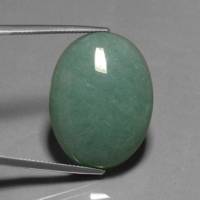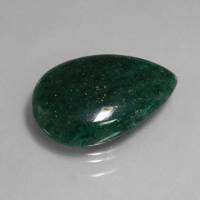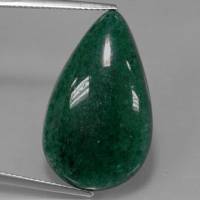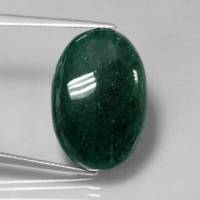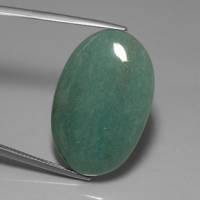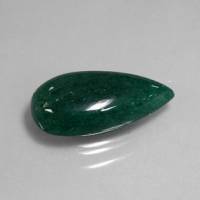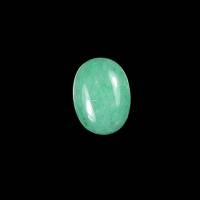Aventurine
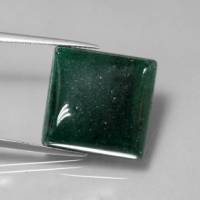
Brazil
19.54 carats
© gemselect.com
Aventurine is a feebly translucent, fine-grained to compact variety of Quartzite, the surface of which has a speckled, metallic sheen, usually of a reddish-brown colour, but occasionally yellow, white, blue or green. This appearance is caused by the presence, in the colourless quartz substance, of numbers of enclosures (scales of mica, plates of chrome-mica fuchsite, etc.), which can always be seen with the aid of the microscope, and sometimes with a simple lens, or with the naked eye.
Also known as Indian Jade.
Aventurine Gemstones by Colour
This table shows the variety of hues this gemstone can be found in. Click on a photo for more information.
Aventurine Gemstones by Size
This table shows distribution of Aventurine gemstone sizes that are listed on this site. This can give a good indication as to the general availability of this gemstone in different sizes.
Contributed photos
Lightest:1.23 cts
Heaviest:36.47 cts
Average:16.51 cts
Total photos:17
Do you have a larger Aventurine? Why not upload a photo?
| General Information | ||||||||||||
|---|---|---|---|---|---|---|---|---|---|---|---|---|
| A variety or type of: | Quartzite, which is a variety of Quartz | |||||||||||
| Other Names/Trade Names: | ||||||||||||
| Chemical Formula |
| |||||||||||
| Synthetic Aventurine | ||||||||||||
| Aventurine-glass is an artificial product which resembles natural aventurine but possesses an even finer appearance. It is a colourless glass in which are embedded numerous small red octahedra, the faces of which are equilateral triangles. The chemical composition of the material, the well-defined crystalline form, together with the red colour and strong metallic lustre of the enclosures, point to the fact that the latter consists of metallic copper. The much lower hardness of aventurine-glass, together with the form of the enclosures, which can be readily made out with a lens, definitely distinguishes it in all cases from natural aventurine and from sunstone. - Precious stones, Max Bauer, 1968, p 503 | ||||||||||||
| Physical Properties of Aventurine | ||||||||||||
| Mohs Hardness | 7 to 6.5, Blue Chart Gem Identification (2010) More from other references | |||||||||||
| Specific Gravity | 2.64 to 2.69, Blue Chart Gem Identification (2010) More from other references | |||||||||||
| Tenacity | Brittle, Gemstones of the world (2001) | |||||||||||
| Cleavage Quality | None, Gemstones of the world (2001) | |||||||||||
| Fracture | Conchoidal,Splintery, Precious stones (1968) | |||||||||||
| Optical Properties of Aventurine | ||||||||||||
| Refractive Index | 1.544 to 1.553, Blue Chart Gem Identification (2010) More from other references | |||||||||||
| Optical Character | Biaxial/-, Blue Chart Gem Identification (2010) | |||||||||||
| Birefringence | 0.007 to 0.010, Blue Chart Gem Identification (2010) | |||||||||||
| Pleochroism | Absent, Gemstones of the world (2001) | |||||||||||
| Dispersion | None, Gemstones of the world (2001) | |||||||||||
| Colour | ||||||||||||
| Colour (General) | Green, red-brown, gold-brown, Gemstones of the world (2001) More from other references | |||||||||||
| Colour (Chelsea Filter) | Reddish, Blue Chart Gem Identification (2010) | |||||||||||
| Causes of Colour | Green, chromian mica (fuchsite) inclusions. Greenish yellow, color center., Pragmatic Spectroscopy For Gemologists (2011) | |||||||||||
| Transparency | Translucent,Opaque, Gemstones of the world (2001) More from other references | |||||||||||
| Fluorescence & other light emissions | ||||||||||||
| Fluorescence (General) | Green aventurine: reddish, Gemstones of the world (2001) More from other references | |||||||||||
| Crystallography of Aventurine | ||||||||||||
| Crystal System | Triclinic, Blue Chart Gem Identification (2010) | |||||||||||
| Habit | Massive, Gemstones of the world (2001) | |||||||||||
| Geological Environment | ||||||||||||
| Where found: | Occurs both in primary deposits and also as loose pebbles., Precious stones (1968) | |||||||||||
| Inclusions in Aventurine | ||||||||||||
| Aventurescence caused by platy inclusions of green mica (fuchsite) - Blue Chart Gem Identification, Herve Nicolas Lazzarelli, 2010, p 7 | ||||||||||||
| Further Information | ||||||||||||
| Mineral information: | Aventurine information at mindat.org | |||||||||||
| Significant Gem Localities | ||||||||||||
| ||||||||||||


